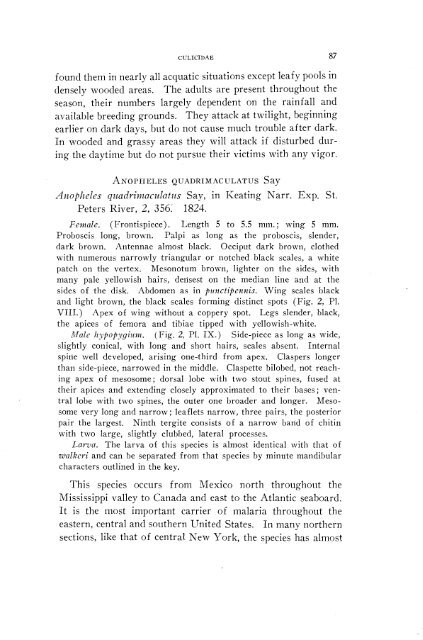a handbook of the mosquitoes of north america - Systematic Catalog ...
a handbook of the mosquitoes of north america - Systematic Catalog ...
a handbook of the mosquitoes of north america - Systematic Catalog ...
You also want an ePaper? Increase the reach of your titles
YUMPU automatically turns print PDFs into web optimized ePapers that Google loves.
CULICIDAE<br />
found <strong>the</strong>m in nearly all acquatic situations except leafy pools in<br />
densely wooded areas. The adults are present throughout <strong>the</strong><br />
season, <strong>the</strong>ir numbers largely dependent on <strong>the</strong> rainfall and<br />
available breeding grounds. They attack at twilight, beginning<br />
earlier on dark days, but do not cause much trouble after dark.<br />
In wooded and grassy areas <strong>the</strong>y will attack if disturbed dur-<br />
ing <strong>the</strong> daytime but do not pursue <strong>the</strong>ir victims with any vigor.<br />
ANOPHELES QUADRIMACULATUS Say<br />
Aszopdze1e.s quadrinmcuht~ts Say, in Keating Narr. Exp. St.<br />
Peters River, 2, 356.’ 1824.<br />
Fenzale. (Frontispiece). Length 5 to 5.5 mm.; wing 5 mm.<br />
Proboscis long, brown. Palpi as long as <strong>the</strong> proboscis, slender,<br />
dark brown. Antennae almost black. Occiput dark brown, clo<strong>the</strong>d<br />
with numerous narrowly triangular or notched black scales, a white<br />
patch on <strong>the</strong> vertex. Mesonotum brown, lighter on <strong>the</strong> sides, with<br />
many pale yellowish hairs, derisest on <strong>the</strong> median line and at <strong>the</strong><br />
sides <strong>of</strong> <strong>the</strong> disk. Abdomen as in punctipemis. Wing scales black<br />
and light brown, <strong>the</strong> black scales forming distinct spots (Fig. 2, Pl.<br />
VIII.) Apex <strong>of</strong> wing without a coppery spot. Legs slender, black,<br />
<strong>the</strong> apices <strong>of</strong> femora and tibiae tipped with yellowish-white.<br />
Male lzypopygitim. (Fig. 2, Pl. IX.) Side-piece as long as wide,<br />
slightly conical, with long and short hairs, scales absent. Internal<br />
spine well developed, arising one-third from apex. Claspers longer<br />
than side-piece, narrowed in <strong>the</strong> middle. Claspette bilobed, not reach-<br />
ing apex <strong>of</strong> mesosome; dorsal lobe with two stout spines, fused at<br />
<strong>the</strong>ir apices and extending closely approximated to <strong>the</strong>ir bases; ven-<br />
tral lobe with two spines, <strong>the</strong> outer one broader and longer. Meso-<br />
some very long and narrow; leaflets narrow, three pairs, <strong>the</strong> posterior<br />
pair <strong>the</strong> largest. Ninth tergite consists <strong>of</strong> a narrow band <strong>of</strong> chitin<br />
with two large, slightly clubbed, lateral processes.<br />
Larva. The larva <strong>of</strong> this species is almost identical with that <strong>of</strong><br />
walkeri and can be separated from that species by minute mandibular<br />
characters outlined in <strong>the</strong> key.<br />
This species occurs from Mexico <strong>north</strong> throughout <strong>the</strong><br />
Mississippi valley to Canada and east to <strong>the</strong> Atlantic seaboard.<br />
It is <strong>the</strong> most important carrier <strong>of</strong> malaria throughout <strong>the</strong><br />
eastern, central and sou<strong>the</strong>rn United States. In many nor<strong>the</strong>rn<br />
sections, like that <strong>of</strong> central New York, <strong>the</strong> species has almost<br />
87

















